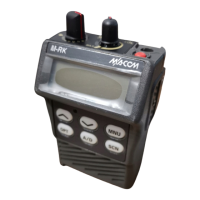of seven watts at pin 7. The output at pin 7 is connected
through the LPF/DC/SW module. A minimum power level of
five watts is on the output of the LPF/DC/SW module.
LPF/DC/T/R SW Module (U8)
The output of the PA module is connected to
LPF/DC/SW. This network is a passive LC low-pass filter
with an insertion loss of less than 1.2 dB in the pass-band. It
also has a rejection greater than 50 dB in the stop band. The
output of this module is connected to the system antenna or
to the UDC connector.
Receive Circuit
The M-RK receive circuit, as shown in Figures 3 and 4,
consists of the following circuits:
• RF Amplifier/Mixer
• First If Amplifier
• Second IF Amplifier/Discriminator
RF Amplifier/Mixer
The Rf Amplifier/Mixer circuit (Figure 11) contains two
third-order band-pass filters (FL301 and FL302), and RF
amplifier circuit (Q3O1) and a double-balanced diode mixer
circuit (Z2). RF from the antenna or UDC connector is cou-
pled through LPF/DC/TR SW module to the input of the RF
amplifier circuit. The RF signal on the input of the RF am-
plifier is first coupled through band-pass filter FL301 to the
input of grounded emitter broad-band RF amplifier transistor
Q301. This amplifier provides 13 dB of power gain to reduce
thermal noise. The output of the RF amplifier is coupled
through band-pass filter FL3D2 to drive double balanced
mixer circuit Z2.
The RF signal from the RF amplifier and the injection
frequency from the synthesizer circuit, provide a 55.025
MHz IF on the output of the mixer. The double-balanced
Mixer has a typical conversion loss of 7.5 dB between the Rf
input and IF output. All inputs and the output of the RF Am-
plifier/Mixer have 50 ohms matching impedance. The +7
dBm injection frequency level, provided by the synthesizer
and amplifier circuit transistor Q103, is connected to the in-
jection frequency input. The output of the Mixer circuit is
connected to the input of the first IF Amplifier.
First IF Amplifier
The first IF amplifier contains a amplifier circuit and two
crystal filters of two poles, respectively (refer to Figure 12).
The first IF signal (55.025 MHz) connects to the input of
preamplifier transistor Q302 through pre-crystal filter FL303
with an impedance of approximately 3 Kohms. Pre-amplifier
Q302 provides a 23 dB power gain. The output is connected
to the input of IF amplifier IC U11 through crystal filter
FL304.
Second IF Amplifier/Discriminator (U11) Non-switchable
The Second IF Amplifier/Discriminator circuit (Figure
13) contains FM IF IC U11 and 455 kHz ceramic filters
FL305, FL306, FL307. The FM IF IC contains a local oscil-
lator, mixer, IF amplifier, FM detector, and an audio ampli-
fier. The 55.025 MHz IF output from the first IF amplifier is
connected to the input of second IF amplifier U11 pin 21
and converted to the second IF frequency (455 kHz). The
second IF output is connected to pin 7 input through the 455
kHz ceramic filter to the IF amplifier and FM detector cir-
cuits. The recovered audio from the FM IF IC is connected
to J1-3B.
Second IF Amplifier/Discriminator (U11) Switchable
The Second IF Amplifier/Discriminator circuit (Figure
14) used in a switchable radio (25/12.5 kHz channel spacing)
contains IC U11 and 455 kHz ceramic filters FL305, FL306,
FL307 and FL308 (used for 12.5 kHz channel spacing).
U11 contains a local oscillator, mixer, IF amplifier, FM de-
tector and an inverter.
The 55.025 Mhz IF output from the first IF amplifier is
connected to the input of the second IF amplifier at U11-16.
There the mixer circuit converts the signal to the second IF
frequency (455 kHz). The second IF output at U11-3 is fed
through ceramic filters FL305 and FL306. Bi-lateral
switches U13 and U14 are controlled by the T/R switch and
25/12.5 kHz controls from the control board.
When operation is selected for 25 kHz channel spacing,
the second IF frequency is passed by FL307 to U11-5 to the
IF amplifier and FM detector circuits. The recovered audio
is passed through bi-lateral switch S12 to J1-3B.
When operation is selected for 12.5 kHz channel spacing,
the second IF frequency is passed by FL308 to U11-5 to the
IF amplifier and FM detector circuits. The recovered audio
is passed through bi-lateral switch S12 to U11-8. There the
audio passes through an inverter to the output of U11-7 and
then to J1-3B.
Synthesizer Circuit
The Synthesizer circuit (Figure 15) contains
Phase-Lock-Loop (PLL) module U2, VCTCXO Reference
Oscillator module Z1, TX/RX Voltage Controlled Oscillator
(VCO) module U5, and a Low-Pass-Filter (LPF) amplifier.
LBI-38735
9

